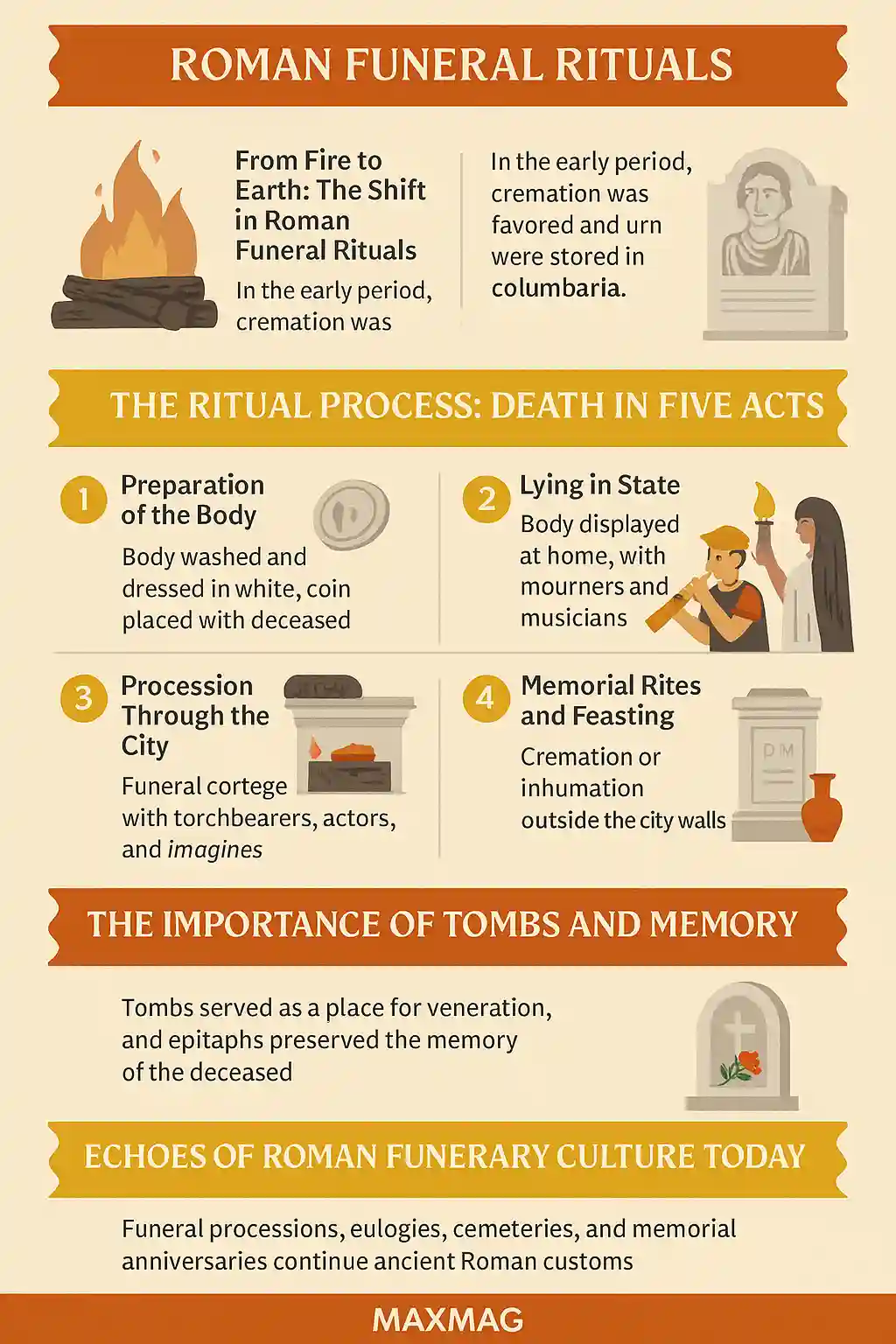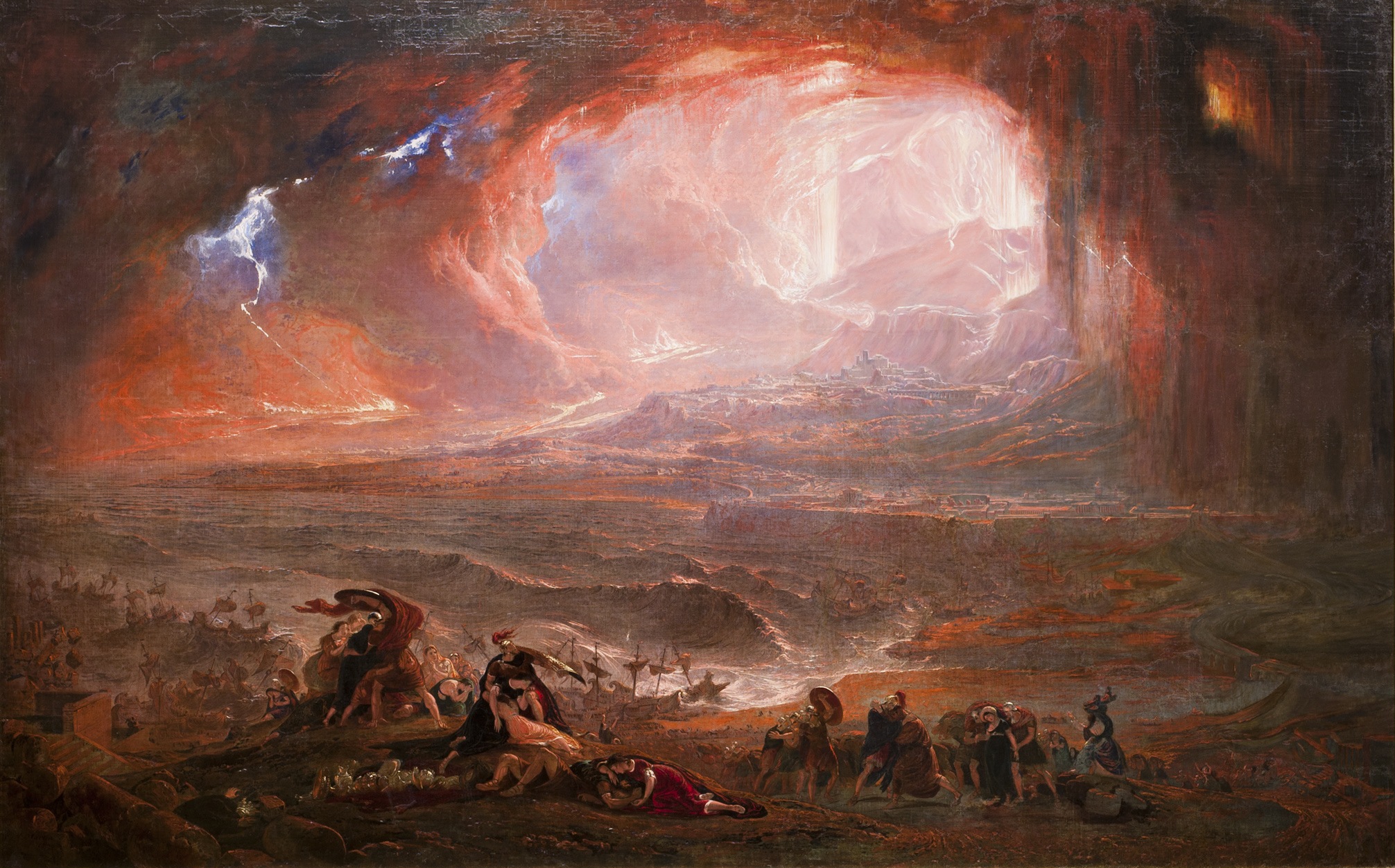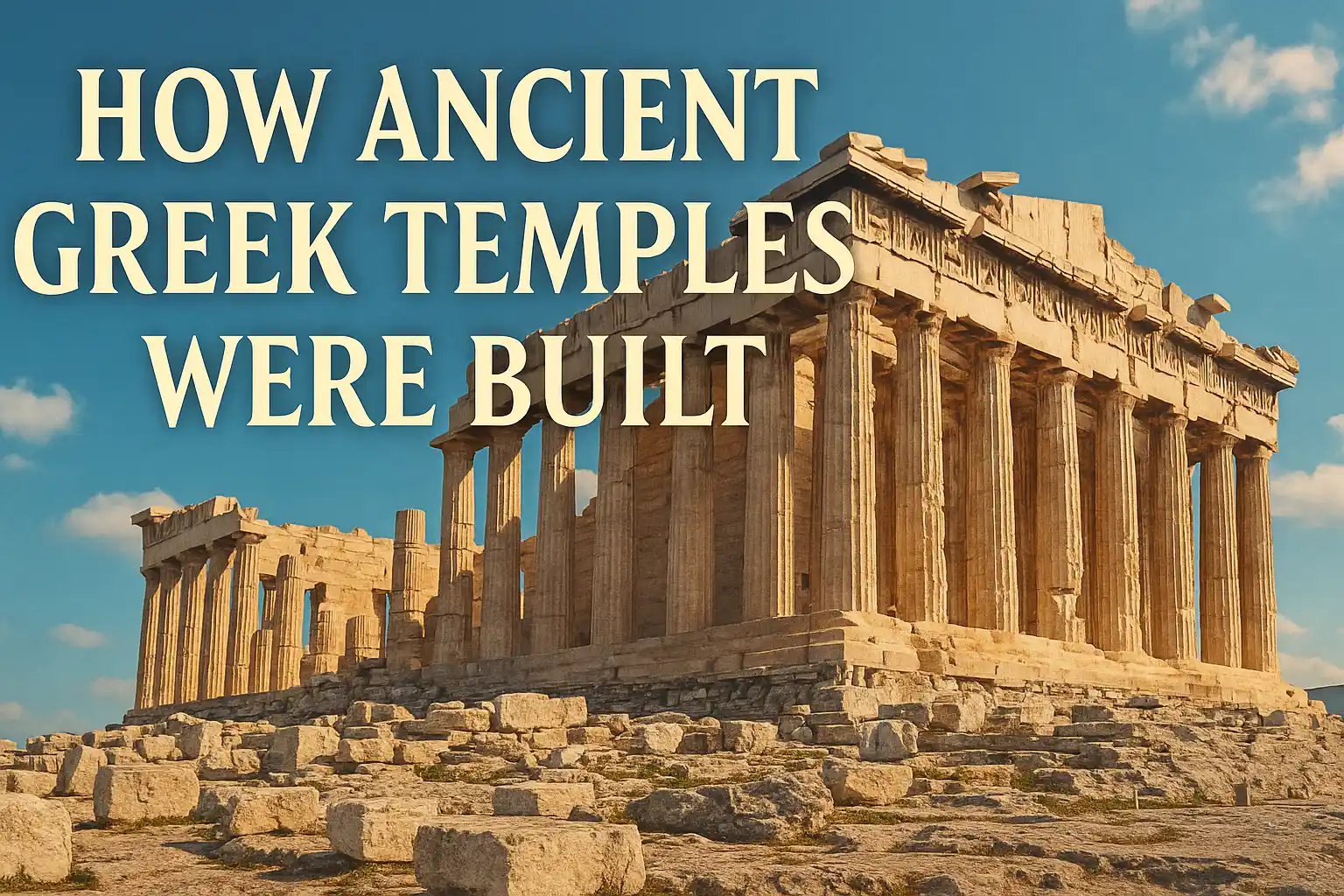
Roman funeral rituals were far more than a final goodbye—they were a profound reflection of Roman values, beliefs, and social identity. From cremation to tomb dedications and elaborate public ceremonies, these rites offered the deceased a passage into the afterlife while reinforcing the social fabric of the living. In this article, we delve into the fascinating traditions surrounding death in ancient Rome, tracing the evolution of funerary customs and their enduring influence on Western culture.
From Fire to Earth: The Shift in Roman Funeral Rituals
In early Roman history, cremation was the dominant burial method. The body was placed atop a pyre, ceremoniously set ablaze, and the ashes collected in urns for burial. These urns were typically stored in columbaria—communal, dovecote-style burial chambers located outside the city walls.
However, by the 2nd century CE, a significant cultural transformation began. Romans increasingly adopted inhumation, the act of burying the body intact. This change reflected evolving religious beliefs, particularly with the rise of mystery cults and Christianity, which emphasized bodily resurrection.
This shift marked a turning point in Roman funeral rituals. No longer just about purification through fire, the rituals now embraced the preservation of the body as a vessel for eternal life. Sarcophagi became popular, often decorated with mythological scenes or portraits, reflecting both personal piety and elite status.
The Ritual Process: Death in Five Acts
A Roman funeral was a carefully choreographed event, steeped in tradition. While the precise steps varied by era and class, most Roman funeral rituals followed a structure that included:
1. Preparation of the Body
The family washed the corpse, anointed it with oils, and dressed it in white—the toga pura. A coin was often placed in the mouth or over the eyes as Charon’s obol, a payment for the mythical ferryman who guided souls across the river Styx.
The deceased would lie in state at home for several days. The body was displayed on a couch covered in flowers and surrounded by candles. This period allowed friends and family to pay respects, mourn, and reflect.
2. Professional Mourners and Music
Roman funeral rituals often involved professional mourners—typically women hired to cry, chant, and tear their garments. Musicians played flutes or horns to accompany the mourning, creating an emotional atmosphere. This theatrical mourning was both a spiritual necessity and a public statement of the family’s grief and status.
Public Spectacle: The Funeral Procession
3. Procession Through the City
Once the lying-in period ended, a funeral procession (pompa funebris) began. The body was carried on a bier, accompanied by torchbearers, musicians, dancers, freedmen, and slaves. In elite funerals, actors wore wax masks (imagines) representing the family’s ancestors, emphasizing lineage and nobility.
The procession moved through Rome’s streets, often stopping at the Forum for a eulogy. This public display was not just a tribute but a political statement. It allowed the family to remind the public of their heritage, virtues, and civic contributions.
4. Final Rites and Burial
The final destination was a necropolis—literally “city of the dead”—outside the city walls. Depending on the practice of the time, the body was either cremated on a pyre or placed directly in a tomb.
After cremation, the remains were collected, washed with wine, and placed in an urn. In cases of inhumation, sarcophagi were used. These containers could be ornately carved with mythological or personal themes, such as Hercules, Orpheus, or scenes of rural life.
Tombs were often placed along roads leading into Rome. The Smithsonian’s Human Origins Program offers valuable context on how human cultures—including Rome—have treated death across time.

Commemoration and Continuing Bonds with the Dead
5. Memorial Rites and Feasting
Funerals did not end with burial. Roman funeral rituals extended into the commemoration phase, including the coena novendialis—a feast held on the ninth day after burial. This meal symbolized the soul’s passage into the afterlife and reintegration of the living into society.
Families regularly visited tombs to make offerings—wine, food, incense, and flowers. Small pipes led into the graves to deliver these offerings directly to the deceased. On annual festivals like Parentalia, families gathered to clean tombs and share meals with their ancestors.
This relationship with the dead was reciprocal. The living remembered the deceased; in return, the spirits (manes) were believed to offer protection, guidance, or peace.
The Importance of Tombs and Memory in Roman Society
In Roman society, the tomb served multiple purposes: spiritual shelter, status symbol, and historical marker. Elite tombs were designed to impress, with inscriptions (epitaphs) detailing the deceased’s name, age, achievements, and virtues.
Public figures like Caecilia Metella, whose monumental tomb still stands along the Appian Way, were immortalized through architecture. Even freedmen—former slaves who gained Roman citizenship—built impressive tombs to assert their social advancement.
Inscriptions often included poetic verses or humorous epigrams. Some read: “Do not disturb this tomb—it is all I have!” Others celebrated marriage, work, or military service. The Metropolitan Museum of Art preserves several such sarcophagi, offering a window into Roman funerary artistry.
Class Divides in Roman Funeral Rituals
While Roman funeral rituals shared core elements, they varied greatly by wealth and status. For the wealthy elite, funerals were lavish affairs:
-
Elaborate biers
-
Gold-threaded clothing
-
Statues or busts
-
Performances of ancestral deeds
By contrast, poor citizens had simpler rites. To ensure proper burial, many joined collegia funeraticia, mutual-aid societies that provided funds for a modest ceremony. These clubs pooled money for tombs, urns, and processions, making funeral rights accessible to the lower classes.
This divide reveals how funerals were both spiritual rituals and social performances.
Gender and the Role of Women
Women had prominent and multifaceted roles in Roman funeral rituals. While barred from formal politics, they were vital in death-related rites:
-
Mothers and wives organized and funded funerals.
-
Praeficae (professional mourners) were women skilled in ritual lamentation.
-
Vestals, sacred virgin priestesses, played key roles in state funerals.
Epitaphs also honored women’s domestic virtues: “She was chaste, loyal, and loved her household.” These inscriptions acted as moral instruction for future generations.
Roman women, through mourning and memorialization, shaped the emotional and ceremonial landscape of death.
Religion and the Transition to Christianity
Traditional Roman funeral rituals were deeply intertwined with polytheistic beliefs. Death involved rituals to avoid haunting by restless spirits (lemures) and ensure peace for the soul (manes). Libations and sacrificial offerings were common.
With the spread of Christianity, these rituals transformed. Christians rejected cremation, favored burial, and emphasized spiritual resurrection. Catacombs became key burial spaces, featuring Christian iconography such as the fish, lamb, and shepherd.
This religious transition influenced burial art, tomb architecture, and perceptions of death, contributing to the Christian funeral traditions seen today.
Echoes of Roman Funerary Culture Today
Modern funerals still bear marks of Roman influence:
-
Funeral processions reflect ancient pompa funebris.
-
Eulogies trace their roots to Roman orations.
-
Cemeteries remain outside city limits, echoing Roman laws.
-
Memorial anniversaries parallel Parentalia and Lemuria festivals.
Even burial practices like cremation and tombstone epitaphs owe a debt to Roman tradition. For example, Roman urns are echoed in today’s cremation vessels, and the act of leaving flowers at gravesites recalls Roman offerings.
Understanding Roman funeral rituals helps us see how our culture continues to honor the dead in remarkably ancient ways.
Roman Funeral Rituals in Art and Literature
Roman poetry and theater often addressed death. Writers like Ovid, Horace, and Virgil referenced funeral customs, burial rites, and philosophical views on mortality.
In Aeneid, Virgil describes elaborate funerary rites for heroes, reflecting both real-world customs and mythological ideals. Roman art, meanwhile, displayed funerary scenes in frescoes, mosaics, and reliefs.
These sources serve as invaluable records of Roman funeral rituals—not just what people did, but what they felt, feared, and hoped for in the face of death.
Conclusion: A Culture That Remembered Its Dead
Roman funeral rituals were a mirror of their civilization. They revealed how Romans honored ancestry, upheld social order, and prepared the soul for the next world. These traditions evolved over time—from fire to earth, from paganism to Christianity—but their essence remained the same: a deep respect for death as part of life.
Whether expressed through an extravagant public ceremony or a modest family gathering, these rituals offered comfort, meaning, and continuity across generations.
As we reflect on modern funerary practices, it becomes clear that the Roman approach to death still resonates. In the act of remembering, we keep the spirit alive.
❓FAQ
Q1: What were Roman funeral rituals like?
They included washing the body, public viewing, musical procession, cremation or burial, and regular commemorations with offerings.
Q2: Why did Romans shift from cremation to burial?
The shift reflected changing religious beliefs, especially with the rise of Christianity and the idea of bodily resurrection.
Q3: What roles did women play in Roman funerals?
Women organized rites, mourned publicly, and were honored in inscriptions. Priestesses and professional mourners also played key roles.
Q4: How did Romans maintain bonds with the dead?
They visited tombs, made offerings of food and drink, and celebrated festivals like Parentalia and Lemuria to honor their ancestors.
Q5: Are modern funerals influenced by Roman traditions?
Yes. Features such as processions, gravestones, eulogies, and memorial anniversaries all reflect Roman funerary influence.




